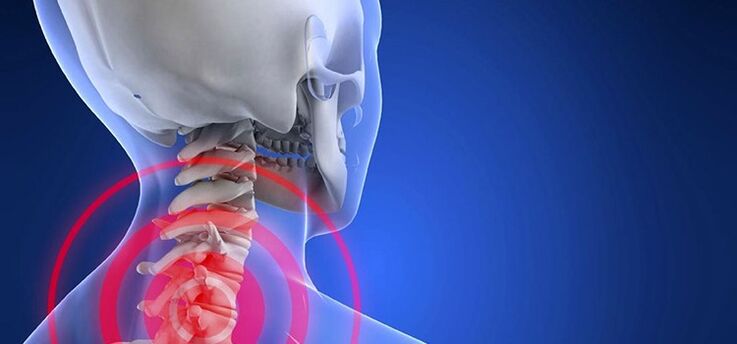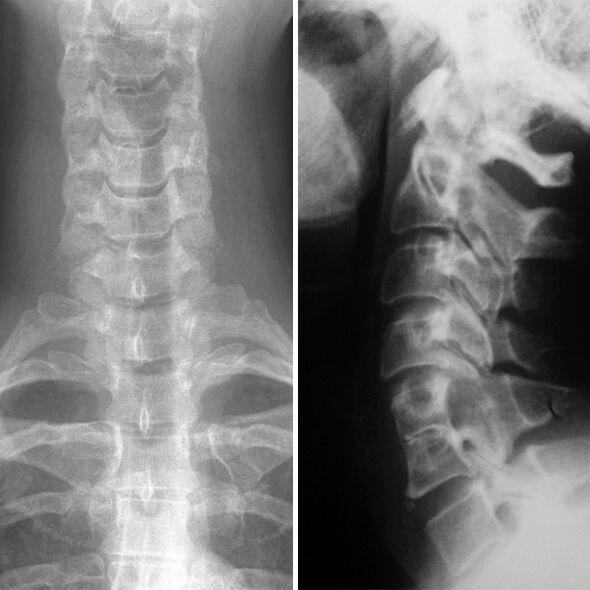
Osteochondrosis of the cervical region is one of the most common diseases of the spine, which can be explained by the great mobility of this part of the body.As the disease develops, strong pain occurs, which significantly worsens the quality of human life.That's why it is so important in the first events of the pathology to consult a doctor.
Clinic of osteochondrosis of the cervical column
The violation is progressive and consists in the appearance of dystrophic changes in the discs of the spine.There are seven vertebrae in this place that provide free head movements.Due to an increase in physical effort or insufficiently strong muscles, this spine is often subject to this violation.
With the development of the disease, the metabolic processes in the spine are disturbed, the strength and elasticity of the intervertebral disc have disappeared and the increased loads lead to the fact that cracks occur on the fibrous ring.As the process develops, the protrusion or hernia appears.
The degree of development
- The first degree.The disease causes a small symptom.A person feels small pains in the neck, increasing with head turns.During the exam, the doctor can identify a small muscle tension.
- The second degree.This form is characterized by tangible pains and can give it to hand or shoulder.This is due to a violation of the height of the disc that causes pinches of nerves.Pain syndrome becomes stronger when the head moves.This state is characterized by headaches, increase of weakness, decrease in work capacity.
- The third degree.The manifestations of the anomaly are increasing many times and the pain is constantly present.They can be heard not only in the neck itself, but also to influence the shoulder or arm.The formation of an hernia leads to the weakness of the hands.A person complains of chronic fatigue and dizziness.At the exam, the doctor can detect a violation of neck mobility.In addition, the patient has pain during palpation.
- The fourth degree.At this stage, the intervertebral disc is completely destroyed, which leads to the formation of connective tissue in its place.Even in the patient, dizziness increase significantly, the coordination of the movements is disturbed and there is noise in the ears.These symptoms are a consequence of the use of vertebral artery in the pathological process - is responsible for the nutrition of the cerebellum and the brain area.
Reasons
Under the influence of various factors, the load increases on the cervical compartment.The muscles are trying to compensate for this process, which causes cramps and problems with blood circulation.For this reason, degenerative processes arise.
The main causes of the disease are as follows:
- deficiency of motor activity;
- violation of the metabolism;
- improper posture;
- Excess weight;
- scoliosis;
- systematic muscle tension;
- stressful situations;
- dysplastic anomalies of the connective tissue;
- problems with blood circulation in the neck;
- inheritance;
- uncontrolled physical activity;
- spine anomalies.
Contrary to popular belief, osteochondrosis can be identified not only in the elderly.Today, this violation is not rare even between children and adolescents.In addition, the number of illness cases in people is 18-30 years old.
Symptoms and signs of the disease
These or other symptoms of osteocondrosis are present in almost all people.If they are associated with the pronounced pain, it is necessary to consult a doctor immediately.The signs of the pathology include:
- Neck pain.They can give the back of the head, shoulder, eyes or ears.They are often felt during the movements.Sometimes there is pulsating pain.
- Pain in the hands.The discomfort can also be heard in the shoulder, brush, forearm area and also remains at night.
- Violation of the activity of the hands and fingers.A person can lose the sensitivity and strength of the muscles.
- Muscle tension in the morning.
- Noise in the ears.
- Heachache.As a rule, they begin to be warned in the back of the head, and then they feel in the temples and crown.
- Numbness and tingling in the limbs.
- Fainting, dizziness, dark in the eyes.These signs appear more often with negligent movements of the head.
- Numbness of the language.
- Worse hearing and vision.
- Pain in the heart of the heart.
- Increase the size of the connective tissue in the neck.
- Disorders of sleep, memory, attention.
- Changing the item - The appearance of Rauco, weakening of the voice, etc.
Symptoms of cervical osteochondosis
The violations of this spine are characterized by these events:
- systematic headache;
- intercostal neuralgia;
- pressure falls;
- loss of coordination of movements;
- dizziness;
- chronic fatigue;
- pain in the heart;
- infectious pathologies;
- trembling points in front of the eyes;
- noise in the ears;
- numbness of the fingers;
- Pain in the hands and shoulders.
This form of osteochondrosis causes many syndromes and can lead to problems in the functioning of some organs.
For example, this pathology often causes heart disease.Therefore, if these symptoms occur, it is necessary to consult a doctor immediately.
Syndromes
In addition to the general events, a series of syndromes are characteristic of cervical osteocondrosis.Thanks to these signs, it is possible to make an accurate diagnosis and choose therapy.
Koreshka
This condition is often also called cervical roots.Rest syndrome is the result of the pinch of nerves in the neck.As this process proceeds, the pain spread, reaching the shoulder blades.They can influence forearms and fingers.Sometimes patients complain of goosebumps and tingling.
The manifestations of the violation are determined by the position of the pathology.So, when the roots of the central nerve is pinned, the swelling occurs, which affects large, central and indexed fingers.If the roots of the shoulder nerve are affected, the process touches the little finger and the ring finger.
Irritate-reflex
This condition is characterized by serious pain located in the neck or in the neck.Often the discomfort intensifies after a strong movement.As examples of this state, it is worth giving pain after sleep, when the patient abruptly turns his head.The inconvenience can also be heard in the chest or shoulder.
Vail artery syndrome
The main symptom is the headache that pulsate or burn.Often they apply to the back of the head, darkness, whiskey.In addition, the discomfort is often warned over the eyebrows.Pain syndrome intensifies after a long movement.The discomfort increases even after being in an uncomfortable position.With a decrease in immunity, nausea, fainting, hearing problems and violations occur in the functioning of the vestibular apparatus.In addition, vertebral artery syndrome often causes vision problems.Pain in the eye may appear.
Cardiac
First of all, the symptoms of Angina Pectoris appear.This is the reason why there is a threat of a treatment that is not very perousing Angina Pectoris instead of eliminating the main cause of discomfort.
The development of heart syndrome is caused by a pinch of roots of the diaphragmatic nerve or thoracic muscles.Part souls can appear that they feel for a long time.In addition, the discomfort increases with sneezing, coughs, inaccurate movements of the head.
This syndrome is accompanied by tachycardia and extrashole.In this situation, the pain is not reduced even after using anti -anansage drugs.If you make a cardiogram during an attack, there will be no symptoms of blood circulation problems on it.
Complications and consequences
The most dangerous complications include:
- The protrusion of records that causes the formation of an hernia.
- Disc gap with pinch of nerves and blood vessels.In this state, the spinal cord can be squeezed, which is very threatening.
- Radicolopathy - Violation of the nerve roots.
- The formation of osteophytes - the peaks so called on the vertebrae.Consequently, paresis and paralysis often occur.
Dun osteochondrosis can be a dangerous complication of this form of dufhitren.
In this case, the tendons of a person lose the ability to stretch.Consequently, the fingers are deformed and cannot work correctly.

Diagnostics
To diagnose a violation, you need to contact a neurologist.The specialist will prescribe these types of research:
- X -ray;
- computerized tomography;
- Magnetic resonance imaging tomography.
To evaluate the condition of the cervical vessels, it is possible to perform the ultrasound dopplerography.For problems with blood circulation, it is worth performing reoencephalography.You should also contact the Optometrist, who will perform the inspection of the bottom of the eyes.
How to treat
To obtain the desired results, the treatment must be complete.To do this, use medical and non -pharmaceutical techniques.Doctors often prescribe drugs that help eliminate pain and inflammation.
Make sure to accept funds to normalize brain circulation.If the pathology causes muscle tension, it is necessary to take relaxing agents.In addition, vitamin complexes are very useful.
An important role in the treatment of the disease is played by the effects of physiotherapy.Paraffin applications and electrophoresis are particularly useful.In addition, waterproofing, irrudotherapy, massage, acupuncture, magnetotherapy are often prescribed.However, the most effective treatment method is considered therapeutic gymnastic.In particularly difficult situations, you cannot do without surgery.
The osteochondrosis of the cervical column belongs to the category of sufficiently dangerous disorders, because it not only causes pain, but is also able to lead to the development of serious consequences.To avoid the appearance of complications, if some discomfort in the neck, it is necessary to seek medical assistance.




































